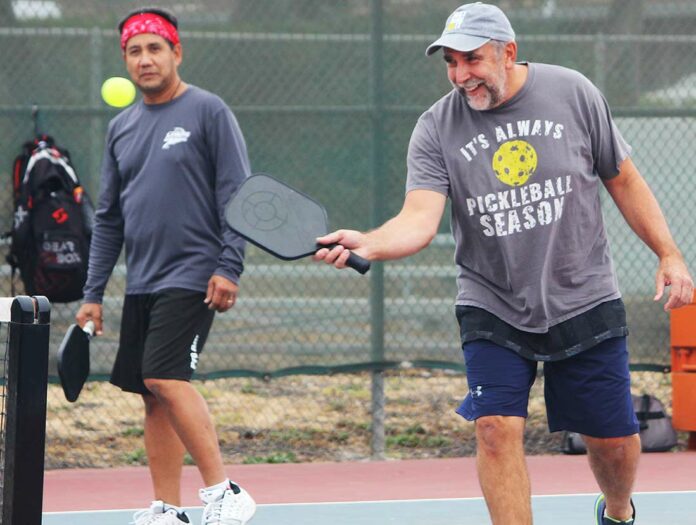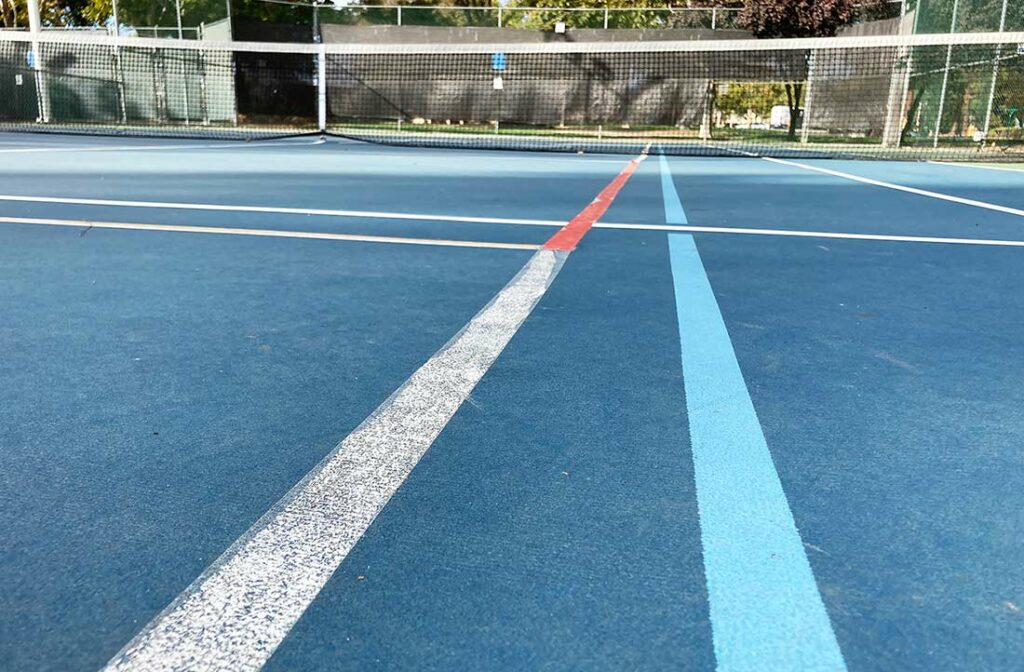
On a recent Wednesday afternoon in San Juan Bautista, a group of about a dozen people, paddles in hand, descended onto San Juan School’s courts to play a few matches of pickleball.
The constant, but satisfying, hollowed pitch sound of the plastic ball being rallied back and forth can just be heard over the constant whoosh of traffic on the adjacent Highway 156, filled with commuters heading back home to San Benito County.
The number of people on the courts on this weekday pales in comparison to the usual turnout on the weekends, where dozens spend their time either competing in leagues or just enjoying the social aspect of the game, speaking to the popularity of this growing sport.
Many of those people are from Gilroy, a city that is beginning to make a name for itself in the sport thanks to the number of talented players nearby, some in the local pickleball community say.
But many of these Gilroyans make the roughly 20-minute drive south to San Juan Bautista because they say the options to play pickleball in their city are extremely limited. When the players were prohibited from playing in their temporary home at the Las Animas Veterans Park tennis courts, it created a divide between them and the Gilroy Tennis Club, which maintains the courts in the city park.
Both sides have aired their differences at recent city council meetings. Pickleball players say they want to coexist with the tennis players, while the tennis club members say they are willing to help them get their own courts.
For now, however, the two sporting communities are pointing fingers at each other.
Temporary solution
Pre-March 2020, the City of Gilroy Recreation offered an indoor pickleball program at the Wheeler Center. Like most other things that were indoors, restrictions brought on by the Covid-19 pandemic forced the city to suspend the program.
However, city officials decided to allow pickleball on courts 5 and 6 at Las Animas Park temporarily until indoor activities could resume. The courts at Las Animas Park have signs posted throughout, stating only tennis is allowed, and “no other sports may be played.”
But tennis players expressed frustration at the number of pickleballers using the courts, as well as the temporary lines they taped to the courts, which they say make it confusing for tennis. Pickleball requires a different, smaller set of lines for players.
The makeshift tape, when removed, left a permanent residue on the court. As a result, courts 5 and 6 were closed earlier this month to allow for resurfacing.
In the summer, Gilroy’s Recreation division resumed indoor pickleball at Wheeler Center for three hours on Mondays and Wednesdays, returning the courts at Las Animas Park to their “tennis-only” use.
Gilroy resident and active pickleball player Steve Ellemberg said the limited hours on weekday mornings at Wheeler Center are not conducive for those who work during the day.
“Does this mean that anyone with a full-time job will be prohibited to play pickleball within the city of Gilroy?” he said.

Tennis players react
In its nearly 50 years, the Gilroy Tennis Club has raised more than $200,000 to maintain the courts at Las Animas Park, according to members, using the funds for resurfacing, replacing nets, installing bleachers and other work.
The courts are recognized by the United States Tennis Association, which allows them to be used for USTA-sanctioned events. Court 6 was fully paid for by the Gilroy Tennis Club.
The club estimates the tape caused $10,000 worth of damage to the two courts. Ellemberg and fellow Gilroy pickleball player Bruce Serpa, meanwhile, say it was a tennis club member who suggested tape in the first place, after temporary lines made with chalk caused too much of a mess.
Ray Blagof, an active member of the Gilroy Tennis Club, said he has “never seen such horrendous issues since pickleball came on board to Las Animas Park.”
“The amount of money we put into those courts are astronomical, and yet pickleball refuses to contribute a dime at least to this moment,” he told the Gilroy City Council on Nov. 1. “They want to take over those courts and they want to take away the ability for us to have tournaments.”
But some pickleball players suggest that the tennis club feels it has exclusive use over the courts at the public city park because it has donated money for their upkeep.
“We really want to coexist,” Serpa said. “They want exclusivity.”
Serpa added that more than 130 pickleball players use the courts weekly.
“How can it be fair to the other citizens of Gilroy to give the Gilroy Tennis Club exclusive rights to a public facility when they do not have any contract or formalized agreement with the city?” he said.
A member of the Gilroy Tennis Club told the council on Nov. 1 that the club “stands by ready to assist” the pickleball players in establishing a permanent court.
Tennis player Ernesto Olivares noted that they are not “anti-pickleballers.”
“I wish for them to continue to have an avenue to enjoy that sport,” he said. “There should be a solution that’s a win-win for pickleball and the City of Gilroy.”
On Oct. 18, the city council agreed to bring the issue for discussion at a future meeting. City Administrator Jimmy Forbis told the council, of which Councilmember Carol Marques is a member of the Gilroy Tennis Club, that the city is evaluating other sites for pickleball.
‘Fastest-growing sport’
In 2018, the San Juan-Aromas Tennis Club raised nearly $18,000 to transform the San Juan School tennis courts into pickleball courts, with the help of $5,000 from the San Juan Bautista City Council.
The club recognized the growing popularity of the sport not just in the region, but the country.
According to the U.S. Pickleball Association, the sport combines elements of tennis, badminton and ping-pong, and is played on a badminton-size court with a modified tennis net. Players use a paddle and a plastic ball with holes.
A Vanity Fair article mentions how numerous celebrities have taken up the sport, and quoted statistics from The Economist that showed pickleball participation grew by 21% between 2019-20, declaring it “the fastest-growing sport in America,” with roughly 4.2 million Americans playing at least once a year.
Ellemberg, a former tennis player, said he turned to pickleball when osteoarthritis in both of his hips limited his mobility and prevented him from playing tennis.
The sport attracts players of all ages, and has proven to be a valuable social experience for older residents who may be suffering from isolation, he added.
Serpa said many players from South Santa Clara County and San Benito County travel to tournaments around the country, and perform well.
“Gilroy is starting to get a good name for pickleball,” he said. “We’re right in the heart of all the talented players.”














As a user of public tennis courts, I have witnessed pickle-ball players adjusting the height of the net by tightening the center strap. [Clearly the inventors thought that they had made the height the same but did not know how to measure the net. As it is now played, there is a 2″ difference in the center height.] Unlike a pickle-ball net, The cable on a tennis net is very strong and tight. The adjustment to the net eventually causes holes in the net and renders the net unusable. A shredded net may stop a pickle ball, but it does not stop a tennis ball that passes below the cable.
However, when the portable pickle ball nets are set sideways to the tennis courts [allowing for two pickle ball courts in the space of one tennis courts] there is no damage to the tennis net or court.
I play both tennis [outdoors] and pickle ball [indoors] and enjoy them both. However, when the pickle ball lobby denies damage to tennis courts, they sound like politicians.